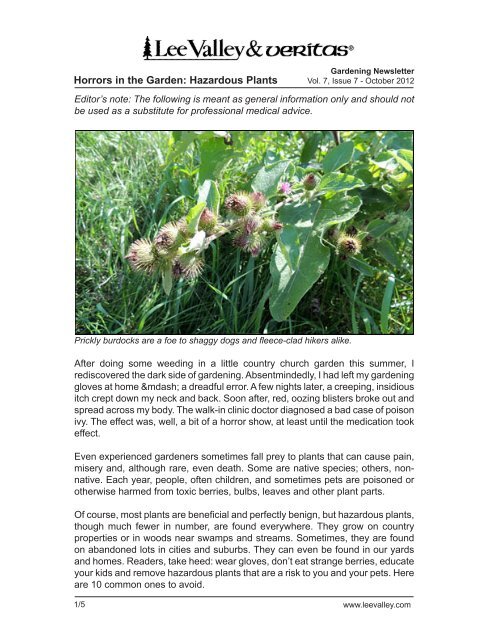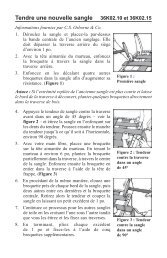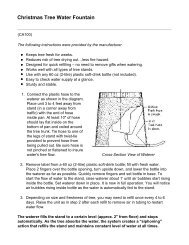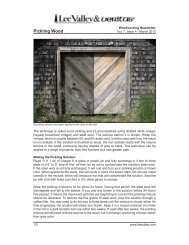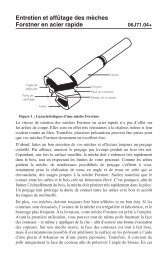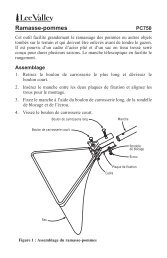Horrors in the Garden: Hazardous Plants - Lee Valley Tools
Horrors in the Garden: Hazardous Plants - Lee Valley Tools
Horrors in the Garden: Hazardous Plants - Lee Valley Tools
Create successful ePaper yourself
Turn your PDF publications into a flip-book with our unique Google optimized e-Paper software.
<strong>Horrors</strong> <strong>in</strong> <strong>the</strong> <strong>Garden</strong>: <strong>Hazardous</strong> <strong>Plants</strong><strong>Garden</strong><strong>in</strong>g NewsletterVol. 7, Issue 7 - October 2012Editor’s note: The follow<strong>in</strong>g is meant as general <strong>in</strong>formation only and should notbe used as a substitute for professional medical advice.Prickly burdocks are a foe to shaggy dogs and fleece-clad hikers alike.After do<strong>in</strong>g some weed<strong>in</strong>g <strong>in</strong> a little country church garden this summer, Irediscovered <strong>the</strong> dark side of garden<strong>in</strong>g. Absentm<strong>in</strong>dedly, I had left my garden<strong>in</strong>ggloves at home — a dreadful error. A few nights later, a creep<strong>in</strong>g, <strong>in</strong>sidiousitch crept down my neck and back. Soon after, red, ooz<strong>in</strong>g blisters broke out andspread across my body. The walk-<strong>in</strong> cl<strong>in</strong>ic doctor diagnosed a bad case of poisonivy. The effect was, well, a bit of a horror show, at least until <strong>the</strong> medication tookeffect.Even experienced gardeners sometimes fall prey to plants that can cause pa<strong>in</strong>,misery and, although rare, even death. Some are native species; o<strong>the</strong>rs, nonnative.Each year, people, often children, and sometimes pets are poisoned oro<strong>the</strong>rwise harmed from toxic berries, bulbs, leaves and o<strong>the</strong>r plant parts.Of course, most plants are beneficial and perfectly benign, but hazardous plants,though much fewer <strong>in</strong> number, are found everywhere. They grow on countryproperties or <strong>in</strong> woods near swamps and streams. Sometimes, <strong>the</strong>y are foundon abandoned lots <strong>in</strong> cities and suburbs. They can even be found <strong>in</strong> our yardsand homes. Readers, take heed: wear gloves, don’t eat strange berries, educateyour kids and remove hazardous plants that are a risk to you and your pets. Hereare 10 common ones to avoid.1/5 www.leevalley.com
<strong>Horrors</strong> <strong>in</strong> <strong>the</strong> <strong>Garden</strong>: <strong>Hazardous</strong> <strong>Plants</strong><strong>Garden</strong><strong>in</strong>g NewsletterVol. 7, Issue 7 - October 20121. St<strong>in</strong>g<strong>in</strong>g Nettle (Urtica dioica):This quick-grow<strong>in</strong>g perennial is oftenfound <strong>in</strong> orchards, untended pastures,farmyards, ditches and waste places.I discovered it a few years ago whilegarden<strong>in</strong>g <strong>in</strong> an old farmyard. Contactcauses a pa<strong>in</strong>ful st<strong>in</strong>g from <strong>the</strong> t<strong>in</strong>y,needle-like hairs on <strong>the</strong> stem, leaf andflower. This is followed by prolongednumbness and itch<strong>in</strong>g that may last afew m<strong>in</strong>utes or even a few days if <strong>the</strong>reis repeat contact. While rarely serious,<strong>the</strong> st<strong>in</strong>g can be nasty.2. Giant Hogweed(Heracleum mantegazzianum):This enormous plant, also called giant The aptly named st<strong>in</strong>g<strong>in</strong>g nettlecow parsnip, is native to Asia. It was<strong>in</strong>troduced to North America as an ornamental garden plant with no knowndiseases or <strong>in</strong>sect pests. It has become an <strong>in</strong>vasive species that can grow tomore than 16’ (5m) tall. It has white, umbrella-shaped flowers and large leavesthat can span 3’ (1m) across. The plant is often found along footpaths andriverbanks, and sometimes f<strong>in</strong>ds its way <strong>in</strong>to a backyard garden.The sap from this plant can cause severe, pa<strong>in</strong>ful burns and can also make yoursk<strong>in</strong> sensitive to sunlight. If <strong>the</strong> sap comes <strong>in</strong>to contact with someone’s eyes, itcan lead to temporary or permanent bl<strong>in</strong>dness.3. Ragweed (Ambrosia spp.):This is considered <strong>the</strong> number onecause of hay fever, <strong>in</strong> part becauseof its abundance and <strong>the</strong> fact that itflowers all summer long. You f<strong>in</strong>d italong driveways, roads, sidewalksand cultivated fields. It tends to growwhere soil has been disturbed (ano<strong>the</strong>rargument for mulch<strong>in</strong>g).Allergy sufferers should steer clear ofthis roadside ragweed2/5 www.leevalley.com
<strong>Horrors</strong> <strong>in</strong> <strong>the</strong> <strong>Garden</strong>: <strong>Hazardous</strong> <strong>Plants</strong><strong>Garden</strong><strong>in</strong>g NewsletterVol. 7, Issue 7 - October 2012While <strong>the</strong>re are dozens of varieties, <strong>the</strong> two that are ma<strong>in</strong>ly responsible for <strong>the</strong>sneez<strong>in</strong>g, runny nose and itchy eyes, mouth and throat are common ragweed(A. artemisiifolia) and giant ragweed (A. trifida). Common ragweed grows toabout 5’ (1.5m). It has long, deeply too<strong>the</strong>d divisions <strong>in</strong> each leaf, and spikesof small, numerous, greenish yellow florets. Giant ragweed grows as tall as 14’(4m). Both varieties beg<strong>in</strong> flower<strong>in</strong>g <strong>in</strong> June and release <strong>the</strong>ir pollen <strong>in</strong> July.Only frost will kill this plant, so <strong>the</strong> pollen cont<strong>in</strong>ues until <strong>the</strong>n. It thrives <strong>in</strong> hot,dry summer wea<strong>the</strong>r. Those who suffer from a ragweed allergy would do best toavoid <strong>the</strong> outdoors dur<strong>in</strong>g <strong>the</strong> middle of <strong>the</strong> day when pollen counts tend to be<strong>the</strong> highest.4. Climb<strong>in</strong>g Nightshade (Solanum dulcamara):Also known as bittersweet, it’s native to Europe but has quickly become a weed<strong>in</strong> North America. It is both a climb<strong>in</strong>g v<strong>in</strong>e and an erect herb. All parts of <strong>the</strong>plant are poisonous, but it is often <strong>the</strong> berries that are mistaken for edible fruit.Consumption br<strong>in</strong>gs on <strong>in</strong>tense thirst, nausea, halluc<strong>in</strong>ations, fever and highblood pressure. Its white or purple flowers resemble those of <strong>the</strong> potato ortomato, to which it is related. The plant flourishes <strong>in</strong> dark, shady spots, produc<strong>in</strong>gpo<strong>in</strong>ted, oval-shaped leaves and tubular flowers.5. White Snakeroot(Eupatorium rugosum):This tall native North American plant,with its showy clusters of small, brightwhiteflowers, is easy to spot grow<strong>in</strong>g<strong>in</strong> fields, woods, thickets, lake edges,waste places and o<strong>the</strong>r shady areas.It grows best <strong>in</strong> basic soil but preferswet soil.The leaves and stems of <strong>the</strong> plantconta<strong>in</strong> an extremely dangerouspoison called tremetol. When animalseat it, <strong>the</strong>y develop a condition called<strong>the</strong> trembles that may cause death.The meat and milk of such animalscan conta<strong>in</strong> tremetol at levels toxic tohumans. Fortunately, this condition israre nowadays because of moderndayfarm<strong>in</strong>g practices.White snakeroot is a danger to graz<strong>in</strong>ganimals such as cows and sheep.3/5 www.leevalley.com
<strong>Horrors</strong> <strong>in</strong> <strong>the</strong> <strong>Garden</strong>: <strong>Hazardous</strong> <strong>Plants</strong><strong>Garden</strong><strong>in</strong>g NewsletterVol. 7, Issue 7 - October 20126. Rhubarb (Rheum rhabarbarum):A spr<strong>in</strong>g ritual for many gardeners is topick fresh rhubarb from <strong>the</strong> garden anduse <strong>the</strong> stalks to make tasty sauces,pies and crumbles; however, <strong>the</strong> large,coarse leaves are toxic. Consum<strong>in</strong>g<strong>the</strong>m can cause nausea, vomit<strong>in</strong>g,burn<strong>in</strong>g <strong>in</strong> <strong>the</strong> mouth and throat,abdom<strong>in</strong>al cramp<strong>in</strong>g and diarrhea.7. Burdock (Arctium spp.):This weed’s purple, rounded flowerheads have hooks that attach tocloth<strong>in</strong>g, hair and animal fur. Brush<strong>in</strong>gup aga<strong>in</strong>st <strong>the</strong>m can result <strong>in</strong> severalhours of serious groom<strong>in</strong>g, especiallyif you happen to be walk<strong>in</strong>g a shaggydog. When pets try to remove <strong>the</strong> pricklyseeds <strong>the</strong>mselves, <strong>the</strong>y can irritateEnjoy rhubarb stems <strong>in</strong> baked goods, butbe sure to avoid eat<strong>in</strong>g <strong>the</strong> leaves.<strong>the</strong>ir sk<strong>in</strong>. If <strong>the</strong>y consume <strong>the</strong>m while do<strong>in</strong>g so, it can cause <strong>in</strong>test<strong>in</strong>al hairballs.Interest<strong>in</strong>gly, burdocks were <strong>the</strong> source of <strong>in</strong>spiration for Velcro®, <strong>the</strong> fabricfastener.8. Buttercup (Ranunculus spp.):A favorite childhood game was to press a wild yellow buttercup to <strong>the</strong> sk<strong>in</strong> justunder <strong>the</strong> ch<strong>in</strong> to test if you liked butter. A slight redness was supposed to be <strong>the</strong>sign of a butter lover. In reality, both buttercups, as well as <strong>the</strong> popular gardenv<strong>in</strong>e clematis (also part of <strong>the</strong> buttercup family), conta<strong>in</strong> a severe sk<strong>in</strong> irritantcalled glycoside. Physical contact with <strong>the</strong> leaves and flowers can cause irritationand blister<strong>in</strong>g. Consumption, which is usually deterred by <strong>the</strong>ir strong, unpleasantflavor, can cause <strong>in</strong>tense burn<strong>in</strong>g of <strong>the</strong> mouth and digestive tract. <strong>Garden</strong>ersshould wear gloves when weed<strong>in</strong>g buttercups or when plant<strong>in</strong>g clematis.9. Jack-<strong>in</strong>-<strong>the</strong>-Pulpit (Arisaema triphyllum):This is an unusual-look<strong>in</strong>g wildflower, with a green and white hood shaped likea pulpit. It produces clusters of red berries, which can be especially attractive tochildren drawn to its showy flowers and foliage. If <strong>the</strong> berries are eaten, symptoms<strong>in</strong>clude a pa<strong>in</strong>ful burn<strong>in</strong>g <strong>in</strong> <strong>the</strong> mouth and throat, swell<strong>in</strong>g and chok<strong>in</strong>g. If largeamounts are consumed, convulsions, coma and death can result.4/5 www.leevalley.com
<strong>Horrors</strong> <strong>in</strong> <strong>the</strong> <strong>Garden</strong>: <strong>Hazardous</strong> <strong>Plants</strong><strong>Garden</strong><strong>in</strong>g NewsletterVol. 7, Issue 7 - October 2012The attractive red berries of Jack-<strong>in</strong>-<strong>the</strong>-pulpit pose a serious health danger if eaten.10. Poison Ivy (Toxicodendron radicans):This woody plant causes countless cases of contact dermatitis <strong>in</strong> humans.“Leaves of three, let <strong>the</strong>m be” is <strong>the</strong> common warn<strong>in</strong>g. The tox<strong>in</strong>, calledurushiol, is easily spread, especially if you scratch <strong>the</strong> affected areas or come<strong>in</strong>to contact with previously contam<strong>in</strong>ated cloth<strong>in</strong>g. Fortunately, <strong>the</strong> rash doesnot spread from one person to ano<strong>the</strong>r. Poison ivy is most dangerous whenburned, as <strong>the</strong> poison rises <strong>in</strong> t<strong>in</strong>y drops <strong>in</strong> <strong>the</strong> smoke and ashes. Breath<strong>in</strong>gthis smoke can cause severe damage to <strong>the</strong> lungs and even death.These are just a few of <strong>the</strong> plants to heed while enjoy<strong>in</strong>g <strong>the</strong> cool crisp days ofautumn. Remember, w<strong>in</strong>ter relief is just around <strong>the</strong> corner!Text and photos by Julianne LabrecheJulianne Labreche is a freelance writer and garden<strong>in</strong>g enthusiast who volunteerswith Master <strong>Garden</strong>ers of Ottawa-Carleton.5/5 www.leevalley.com


